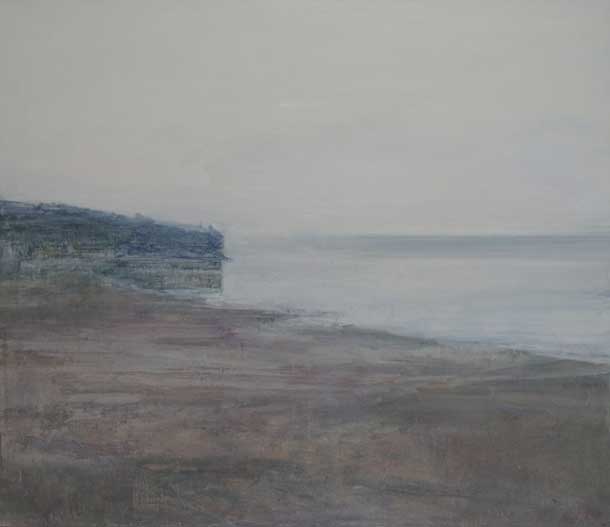
Kurt Solmssen Light Rain, North Bay 2011 Oil 34″ x 40″
click here for a larger view
I had recently watched several of the delightful videos made by John Thorton about his friend, the Seattle based painter Kurt Solmssen .
I was intrigued and arranged for an interview using skype with webcams on our computers where he talked at length about his background and work. Seeing each other face to face on the computer helped turn the interview towards being more of a conversation than a formal interview. I would like to again thank Kurt from taking the time to do this and to share his words about his art and life. Kurt Solmssem shows at the George Billis Gallery in NYC and studied at the Pennsylvania Academy of the Fine Arts.
LG
What are some formative experience that shaped who you are as a painter. How has your work evolved over the years?
KS Well, I didn’t go to art school until I was twenty years old. I’d always been interested in art, but never really painted until right before that. I decided to go to art school. I had started painting on my own and realized, Hey, maybe I’d be good at this and I really enjoy it
So, I looked around at some art schools, and I saw the brochure for the Pennsylvania Academy of Fine Arts. In there they had work by Ben Kamihira, Sidney Goodman, Arthur De Costa, Lou Sloan, Bruce Samuelson. I really liked the work a lot, and it was my hometown, so I ended up going there.
And in those days, the school was in a hotel building, the Belgravia Hotel. And after a couple of years, [the students] could apply and get a studio, which was basically a hotel room with its own bathroom and a bathtub. It was really nice. And the teachers. For example, Ben Kamihira had a suite of hotel rooms in this building. He had models come in. He lived there some of the time. It was a great experience to see these great artists at work. Sidney Goodman was around. Those influences were great. Lou Sloan. I don’t know if you’ve ever heard of him.
video (part 1 of 2) by John Thorton about Kurt Solmssen
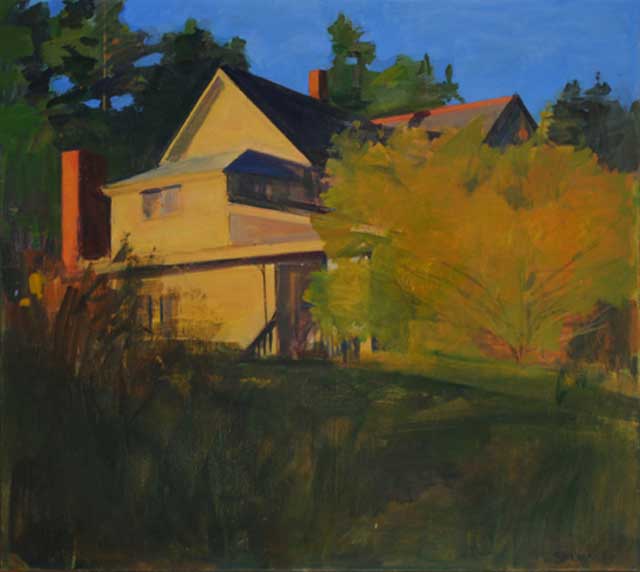
The Yellow House / Winter, Oil 2010 25″ x 28″
LG No, I don’t know him.
KS He taught a lot of people how to paint landscapes at the Pennsylvania Academy. So, I learned a lot from him going out on painting trips. You know, the palette that I have now is pretty much influenced a lot by him.
I just liked working outdoors, just the physical aspect of it. To make it a short answer, if I could get the results I wanted by working in the studio, I wouldn’t work outside. I just found that what I could get from being outdoors, the information that I could get and just the physical thing about being there, was what really made me enjoy that. And I liked getting out of the school studio where there were fifty people with easels. It didn’t feel like I was making art as much as… Or maybe I’m just a bit of a loner. I don’t know.
I was influenced [early on] by the Pennsylvania landscape painters, who did a lot of winter landscapes, like Willis Redfield. He would do these big paintings in the wintertime all at once, large scale paintings. And those were some of my early influences.
LG I’ll have to check. I’m not familiar with him.
KS He did these really amazing things all at once, in really cold temperatures.
KS And Daniel Garber was another one. And George Nick’s work, I saw. A friend of mine, Doug Martenson. He’s another person you might want to look up, Doug Martenson.
He teaches at the Pennsylvania Academy now. He would have George Nick’s painting cards up. The paintings of trucks and so forth. When I first saw Fairfield Porter’s work, I had been painting for a few years. I really responded to those, because they were about his family, his domestic surroundings, and they were so directly painted.
We did a lot of cast drawing in school, and that sort of very academic training, but I wasn’t as interested in that as the more painterly stuff, like the Bay Area painters. Diebenkorn. Hopper was a big influence on me. But I guess about Fairfield Porter, I really liked how he seemed to be influenced by de Kooning and so on, that really direct painterly stuff.
Autumn Yellow House Oil 2011 50 ” x 70 ”
LG When you’re painting, what helps you to reach a state of mind where you find yourself doing your best work? How do you get into that zone where you can turn everything else off, and you’re just there with your painting? Is that something you think about?
KS Less distractions, I guess. One thing about going out in the field, that I like, is that you remove yourself from a lot of distractions. In the beginning, I didn’t like it when people came up off the street and talked to me, but now I’ve gotten used to that.
I like the feeling of going out and finding something to paint, and then coming back, almost like a hunter/gatherer or something. You go out, you do the work, and then you come home; as opposed to always being in the same studio. I do a lot more in the studio now. Sort of both. Paint on-site, in the house, and then also work in the studio. I built my own studio when I moved out west in 1988.
KS As far as what makes me concentrate on painting? I don’t know. The thing about working from life… I talk to Scott Noel about this quite a bit. He, like many artists, likes north light. Very constant. And he’ll just work for ten hours straight. But I tend to like more directional light, especially when I’m outside. The light changes in about three hours, so that kind of gives you a framework, as you know, for doing that.
So, setting up the paint and working for several hours, and then the light changes, and so you’re sort of forced to stop. That gives me a time frame where I really concentrate. Then after a few hours, I come out of that state, whatever it is, of concentration.
LG Of course concentration is critical but another aspect of this you may have experienced, is when there’s other people around me, I become aware of unconsciously playing to an audience rather than to myself. It’s like I catch myself anticipating, What is the viewer going to like? Having a people-pleasing mentality while painting is disagreeable. It usually runs contrary to what the painting really needs. Do you find that?
KS Yes, absolutely, because you’re less self-conscious. And I also think that when I’m working on a painting, that it can go through a state where I’ve destroyed it. I’m going to completely change it. I think this is the worst painting I’ve ever done, maybe after hour one. And then it gets to point where hopefully it’s a lot better than where I started it.
But if you have someone watching you do it, I’m a lot less likely, I think, to go to that place where, Okay, this painting is really bad and then I just completely change it.
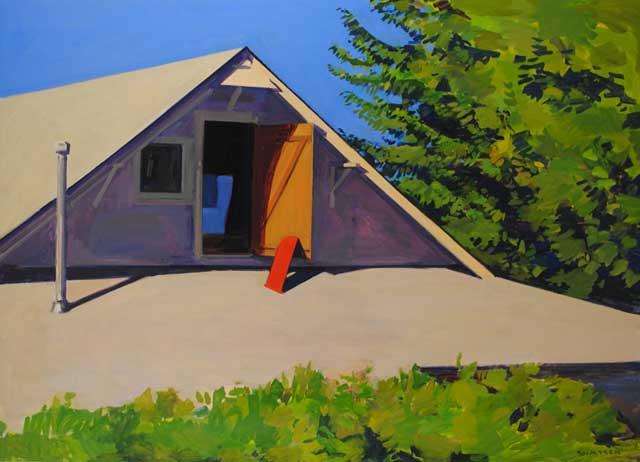
Red Centerboard, Oil 2011 50″ x 70″
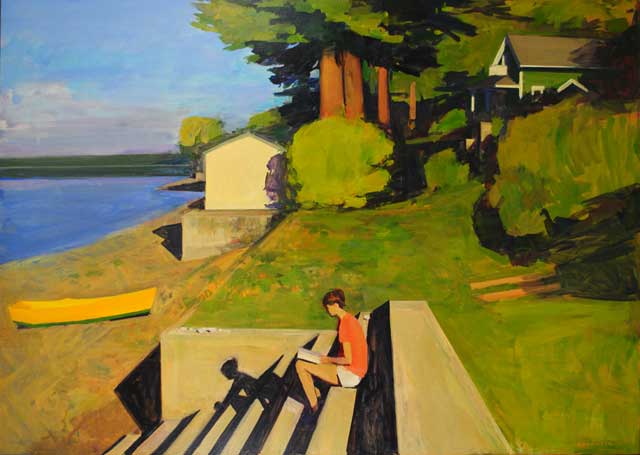
Vaughn Morning, Oil 2010 50″ x 70″
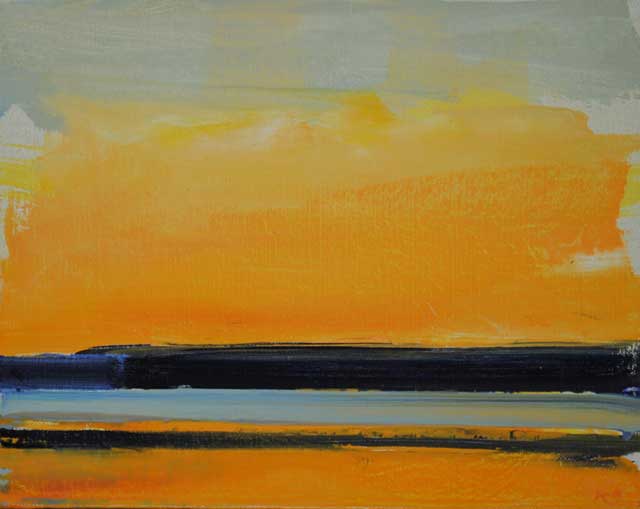
Sunset State 4, Oil 2012 8″ x 10″
LG Tell us something about color in your work. Some of your work uses a higher chroma palette with strong contrast of light and dark and others use a muted, close value with soft atmospheric edges. Is this mainly due to weather conditions and what you are seeing or are there other concerns going on. You often evoke other painters – like Fairfield Porter and Hopper on one hand and Whistler and Monet on the other.
KS Well, the seasons are so extremely different out here in the Northwest. We have so much fog and mist and gray weather in the winter, and then the summers are like Fairfield Porter, like New England clarity. So, just for that reason, the paintings are very different generally. Unless the sun comes out in the winter, we have a very low horizontal light, which is beautiful. But I was just talking about how I work outdoors in snow and rain and stuff. I try to make an abstract, minimalist… There is a kind of abstract, minimalist beauty to the Northwest landscape, and I try to capture that.
LG It was just such a difference in your whole sensibility between the winter and the summer. I guess that makes sense that that’s how you would view it, between your winter and your summer paintings. It’s almost like two different painters were…
KS I’ve heard that…
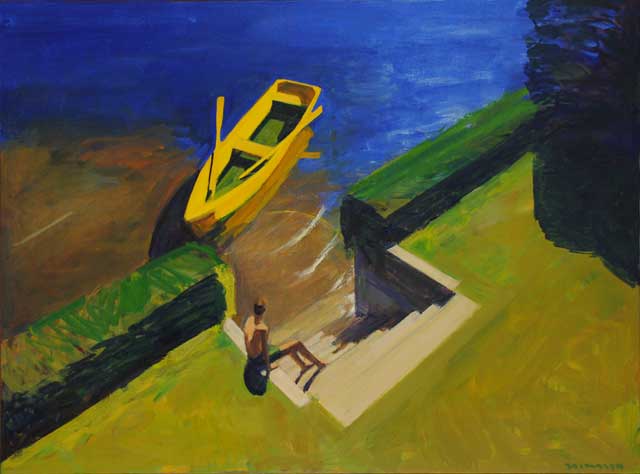
Yellow Boat in a Blue Bay, Oil 2011 34″ x 46″
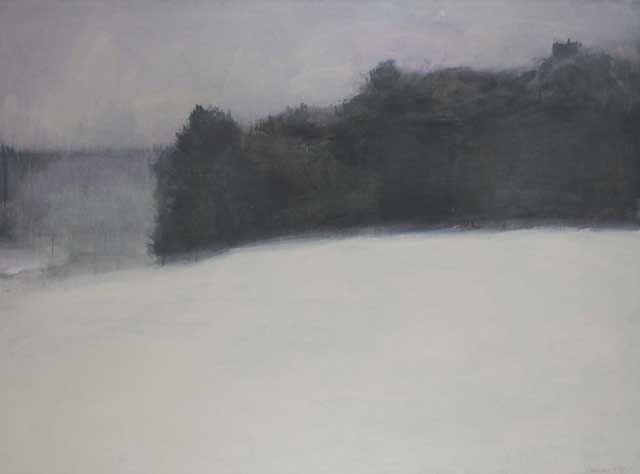
Winter Above Vaughn, Oil 2011 44″ x 60″
LG There is a similarity in the sense of how you’re moving the paint around, it has a real vigorous, gestural quality to both your winter and summer paintings, even the ones where there’s sort of a higher degree of resolve. But the color was interesting in your summer ones. You seem like in your more recent work—I’m not sure—where your color is evolving more, or it’s changing. Can you speak more about your color?
KS I guess I’m not aware… People say they’re very colorful. I don’t always think that they’re that colorful. There is a lot of saturated color, and I’m always trying to keep the color pretty keyed up, but still have them work as representational paintings. I don’t know. I don’t think that artists always realize how their color sensibility or their way of seeing is so different, but each person has their way of seeing and it’s just kind of an individual thing.

Study for Looking Towards Minter 2, Oil 2010 11″ x 20″
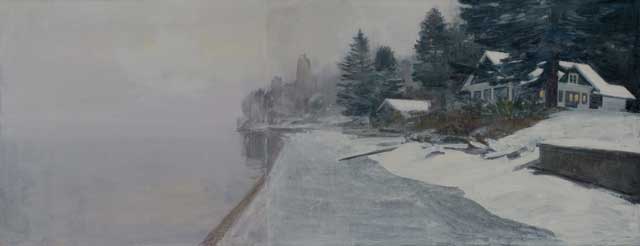
The Davis House In Snow, oil 2009 46″ x 120″ Diptych
LG You often paint large canvases outdoors, what is the appeal for you – putting up with the obstacles of wind, etc. With some of your larger paintings you don’t seem to use an easel and use a very large palette, can you speak about how you go about making one of your larger paintings? I’m curious about your working method.
KS Well, I liked working large scale from the very beginning, relatively large scale outdoors; because as I mentioned, Willis Redfield. I just like the physical thing about working large. And I tried making my own easels to set up outdoors, and they would blow away in the wind. So, as with frame making, also, the simpler, the better. I eventually just found the simplest thing to do is take a piece of 1×2 and attach it to the crossbar on the back of the painting with a little hinge, like a little door hinge, and just wire or tape the bottom part of that to the support.
So then when I go outside (or if I’m even inside) I have a little tripod. I just set the little 1×2 to prop up the painting, and then I set a big piece of plywood as the palette right on the ground. I squat there, and stand up, and sit down, and paint with the paint sitting right on the ground because it’s simpler. I can just pick the painting up when I’m done (there’s no easel) and put it in the truck or take it up to the studio. Carry it on my arm.
Similarly, the palette I like to be big, because I’m trying to mix all these variations in that three-hour period, and I don’t premix colors, so it just gives me more space to work with. I paint outside in the rain and snow a lot, and experiment. I used to put up little lean-tos, kind of like tarps. That became too much work to set those up. I’ve even found that letting the snow and rain land on the oil paint does something which… I’ve done these, I guess you’d call them experiments with mixing oil and water. Really unusual textures and things you wouldn’t be able to reproduce. They’re very unexpected. It’s kind of beautiful in a way.
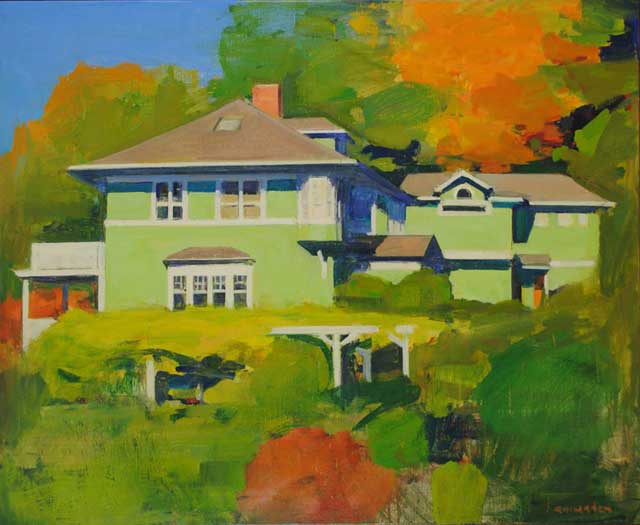
The Green House 2010 Oil 28″ x 34″

Snow on 7th St., Oil 2011 26″ x 36″
LG Now, you keep coming back to some of the same subjects. Over the course of several years, I’ve noticed that you see the same houses, the same views from your yard, I would imagine. Like of the boat, the yellow boat, and the dock…
KS That boat, in particular; that’s a boat that my grandfather bought in 1936 here in Tacoma, and he rode it back to his house. We’ve had it ever since. I just started painting it when I would come out here to visit. It had this Cadmium yellow color which was great in the landscape out there, this blue and green landscape. I don’t know. It’s sort of a symbolic thing. It’s part of my family history. It becomes a part of these semi-narrative paintings. I don’t try to make narratives. It’s more like I’ll see something and want to paint that scene.
LG The houses that you see. There’s a green house and a yellow house that you’ve painted. I imagine they’re all fairly close by. Do you see them fairly regularly?
KS Yeah, we live on a peninsula, and there are some older homes around here. I’ve driven around. I’m always looking for another thing to paint, so there are these old homes that I like to paint in the landscape. You know how Edward Hopper said at one point. He said, “I’ve painted every picture there is to paint here on the cape…” I feel that way, sometimes, until I find the next idea. But there’s this white house with a big porch that I’ve painted many times from different angles.
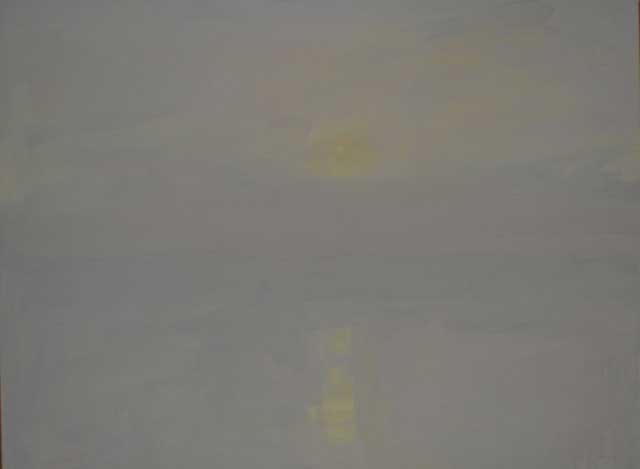
Sunrise Over Water, Oil 2011 30 ” x 40 ”
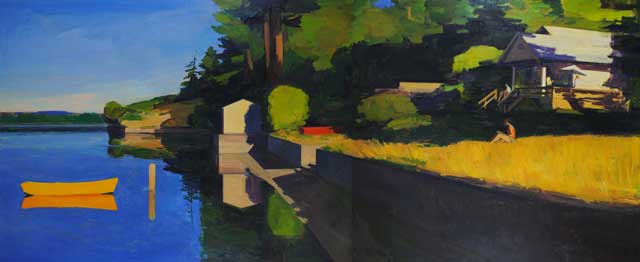
Morning Sunlight, Oil 2011 48″ x 116″ diptych
KS I recently started doing this diptych, really big paintings, like ten-feet long, in two parts. I started those as one canvas, for instance looking up at that white house from the beach, and then I realized I wanted to also show the beach in the distance off to the left.
Antonio López Garcia. You know that painting of a sink where he’s looking down, and then it’s in two parts?
LG Yes, I do know that one. It’s in the Boston MFA.
KS And he said, “Well, you know, you look down and then you look up.” It’s two different angles. And that’s how I felt about this. When you’re there, you think, Well, I see all this expanse, but actually, you have to turn your head to see the whole thing, and it’s really two views. The first landscape I ever painted in Lou Sloan’s class, he came over and said, “Well, you’re painting from all the way on the right to all the way on the left. You don’t really see that much.” So I learned to focus in on something. But with these paintings, I’m trying to just show the whole thing. Having it in two separate paintings that fit together makes sense.
LG So you’re not into showing the sort of distortion that you would get, the perspective that you often see in some people who do that, like Rackstraw Downes…
KS Yeah, like Rackstraw Downes…
LG …and other people who are following on a similar vein.
KS Well, he’s a master. He’s a great artist. He came to speak at the school, and I know how he works. He does these fantastic drawings, and everything’s from life. And he does have this interesting way of bending the perspective. But no, I don’t work like that. By putting these two paintings together, it’s also a practical means. How do I carry around a ten-foot painting? So, also having it in two pieces made sense.
LGWhat do you think is the difference between West Coast landscape painting and East Coast landscape painting? We had started talking about that a little bit before. I’m curious, since you’ve been on both coasts, now, if you have any thoughts about that?
KS Well, the West Coast painters that I liked early on were the Bay Area painters. Diebenkorn, when he did the figurative work. I like all his paintings. But those painters that were working in San Francisco had these big shapes.
There are so many East Coast painters, I don’t know. How do you encompass all that? But I think that I am sort of a hybrid between East and West Coast, because I grew up in Philadelphia and went to the Academy. The Thomas Aikens tradition. It was influenced by Fairfield Porter. But then I spent a lot of my life out here on the West Coast. It’s a different kind of light and somewhat different influences.
After I moved out here, and I started being influenced by the atmosphere, Morris Graves is somebody I mentioned. And Whistler is another one, his nocturnes and so forth. Trying to get ahold of this Northwest winter landscape… I feel like I absorbed a lot of that East Coast/Philadelphia realism from going to school there. Wherever you go to school (and who your teachers are) is going to influence you a lot. And then moving out here, I have that influence on me, too.
I think these different areas of the country have developed in certain ways. I was in Santa Fe, recently, and I learned more about the history of that area and how artists came there to work. And Los Angeles has its own really interesting history. Seattle has its own particular history of certain artists moving there from other places and germinating.
I just think there are really good artists working everywhere in America. They may not show in the same city where they’re living. And I just think that there’s a lot going on everywhere. But New York is still where a lot of people go to bring their work, but I don’t know.
LG Now, what’s the art scene in Seattle like? Is that supportive to landscape painters? People working from observation?
KS Somewhat more than it used to be. When I first moved here in 1987, there was even less of that. It’s definitely not in the mainstream. Seattle has kind of a funky aesthetic. You know, each city has its own solar system of artists. You find this if you’ve shown in different cities and lived in different places. There are certain people who are very well-known.
In the Northwest, there’s Morris Graves [and] that school of painting. I really like [Morris Graves’ work] a lot. But there wasn’t very much of realist painting. I met Gary Fagan and his wife Pamela. They were starting up a little school back then, basically out of their kitchen. It’s now grown into the Gage School. It was first called the Academy of Realist Art, and then the Seattle Academy of Art. She’s from Canada. They lived in New York for a while. I think they went to the Art Students League. They started up this school and started bringing in artists from around the world to teach there, and have really built it into something where this is a community of representational painters.
The history of art in Seattle is interesting. There’s Davidson Gallery, which shows realist work. The owner’s family had a collection of prints. He’s a print dealer, but he also represents a lot of realist artists.
When I came here, the galleries that really interested me were Greg Kucera, who does sort of avant-garde stuff. He doesn’t really show any representational type work. And then (Don) Foster/White Gallery, which showed Morris Graves and Dale Chihuly. And he didn’t really show [any] figurative work, to speak of, but I wanted to be with that gallery just because it was such a good gallery, and I like Morris Graves’ work. So, I approached them. They didn’t know who I was, and it was sort of a long process of them getting to know me.
In the meantime, I started showing in Santa Monica, because I had been approaching Tatistcheff & Co in New York for years. You know, Peter Tatistcheff .
LG Sure. I know the gallery. They’re no longer in existence.
KS No longer in existence, but he was one of the dealers who would talk to art students off the street. So, going back to art school… In Philadelphia we’d go take the train up to New York, and he was someone we could talk to. He would give us some hope that maybe we could show there.
So, Terry Rogers was working at Peter’s gallery in New York at that time, and then he moved back home to Los Angeles and started his own branch of Tatistcheff . So, he knew my work. He got in contact with me and said, “You know, I like your work.” There was someone who was interested in me. So, I started showing in Santa Monica. Every time I had a show there, I’d send the card to Don Foster in Seattle. And then they eventually called me up and said, “Hey, would you like to be in a group show?” So, that’s how that happened. In sort of a roundabout way.
So getting back to your question about Seattle’s art scene. I had to find my way into that, but in the meantime, show in a different city. So, I think you just have to find the right venue that’s interested in your work
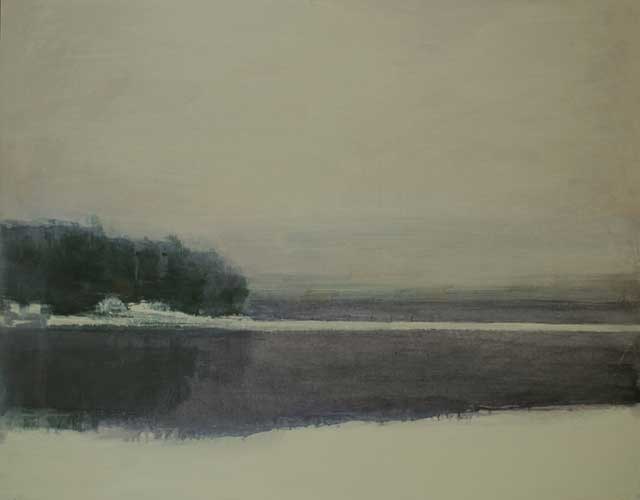
After a Snow Fall Oil 2012 38 ” x 48 ”
LG John Thorton, in one of his videos about you, talks about the difficulty of painters succeeding in the artworld, he quotes the New Yorker article where it talks about: “radiating a half-life of blighted ambitions” (The New Yorker, The Art World, Looking for the Zeitgeist Dec 6 1982 by Calvin Tomkins)
(here is the full quote from this 1982 article…)
“Precious few ever become rich or famous, needless to say, but more and more of them are trying. In its current “Guide to Galleries, Museums, Artists,” the magazine Art in America lists some fourteen thousand artists in this country, each with his or her gallery affiliation. Assuming that for every artist who has a gallery there are at least twenty who want one, it appears that the profession is getting a little crowded. What are we going to do with all these artists, with all this art? Teaching jobs in the fine arts are even harder to come by these days than gallery affiliations. Works of art must be piling up throughout the republic in dangerous profusion, unsold and unseen, radiating a half-life of blighted ambitions.”
30 years later, the over-population of painters today barely leaves room to breathe sometimes. That combined with many galleries closing due to the economy and even that painting itself increasingly becoming irrelevant to the NYC-based artworld, painters have what seems to be an impossible struggle ahead.
KS Yeah, you mentioned about this quotation about unsold artworks radiating a half-life of blighted ambition, and we joked about that when we were art students living in the same house in North Philadelphia. We had a great landlord. We lived in this beautiful, old home in kind of a rundown neighborhood about ten blocks north of the Pennsylvania Academy of Fine Arts on Mt. Vernon Street. That’s where Thomas Eakins used to live, right on that street. And Daniel Garber, also in that neighborhood. It was a beautiful old home with tall ceilings and all sorts of beautiful moldings and everything, and there were five of us at a time living in there.
So, we had this little community of artists. You know, when you get out of school and you start working on your own, it may be harder to keep in touch with other artists. So, as you said about teaching, if you’re in an academic environment, you have that connection. I haven’t done as much teaching, so I am kind of isolated, in a way. I live out in the country, but I do keep in touch with artists that I’ve known since way back in art school.
LG That is a good suggestion to not limit yourself to only trying to show in a gallery where you live. There is so much competition amongst painters now, that it seems like, in my mind anyway (it’s perhaps different for you) but there’s almost no point to competing anymore. The market is just so saturated with a very high painter to buyer ratio, that to my mind, it’s just better to have it all just be a labor of love and just to have the integrity… and to let go of notions of “making it big someday”. You’re probably not going to get ahead anyway. You might as well just do what you want.
KS Yeah, absolutely. It has to be about the work, and there’s no reason to be doing it if you don’t really like what you’re doing.
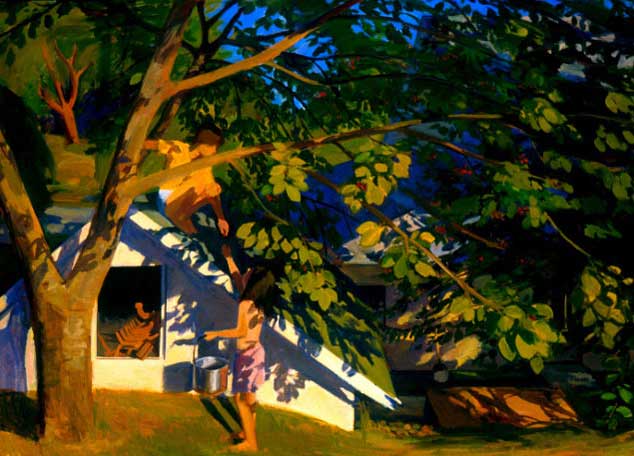
The Cherry Tree 1999 Oil 50″ x 70″
KS My personal story briefly is that while I agree with everything you just said; if I can get a good gallery relationship, and keep that healthy, and have a place to show the work, and sell some of it, and have some kind of following, and just be paying attention to the work I’m doing, and be happy with that, that’s all I could want.
When I was an art student (I had just started in art school) my grandfather said to me, “You should have some other skill or trade.” It’s practical. As it turned out, they were restoring the sculpture collection at the Pennsylvania Academy Museum. I was hired by Virginia Naude, an art conservator, as a lab assistant to help her restore all the sculptures in the museum collection.
Through that I was introduced to another conservator. And so, all these years I’ve been doing sculpture conservation. I get to travel and see collections, fantastic art collections. I walk into a room, or in someone’s house, or in a museum, and I see these works; and I get to work on these fantastic pieces of art I never would even see.
And so, I have that outlook on the art world, and I see the art world on the level of the top tier galleries, anyone you could name, and I realize I’m not in that world, and I never will be, but that’s fine. I show in the best galleries that I can make a connection with, and some of them have been pretty good. But I realize I have my place, and I have my friends, like we were talking about. I met George Nick and Scott Noel. I’m meeting you.
I’m just happy if I can be doing paintings I think are good and getting better. Then that’s all I really want. It’s important to sell some of the work. I really try hard to keep a good gallery relationship. And that’s a whole other thing I really feel strongly about, that artists should realize that keeping that relationship strong is really important in terms of bringing people to the gallery, and everything being transparent, as much as possible.
LG You work with the George Billis gallery? Is that your main gallery? …
KS Yes, it is right now. Yes. I had been showing at the Tatistcheff, the first show I got in New York. It was on 57th Street and everything was nice, but that went bad. He had financial problems. And it took me a long time to get another gallery. So I met George, He’s a pretty young guy. I just met him. I was there one day with Scott Noel, just looking at galleries and just struck up a conversation. That eventually led to being in a group show and then having a show. And it’s really tough if you lose a gallery to get another one. So, I think it’s really important for anyone to appreciate, if you can get one, just to keep that relationship healthy.
LG Right. Especially with the economy the way it is. A number of very big galleries have gone under. And so, all the ones who were in good galleries that have closed are now moving into the other ones, and making it even more impossible.
I think you had asked me one of these questions about how do you make it [and] survive in the art world. And my answer to that would be try to keep expenses low, the overhead low. Certainly in the beginning. And building a studio was one of things I wanted to do to…

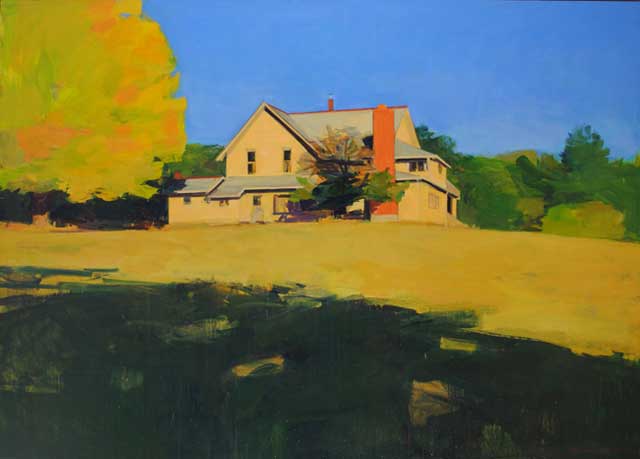




Hi – It should be noted that the ‘Thomas Aikens’ that my friend Kurt is referring to is Thomas Eakins (pronounced Aikens) the great American Realist. Eakins had a very controversial history at the Pennsylvania Academy, and was eventually forced to resign. Thomas Anchutz, who worked behind the scenes to have Eakins removed, succeeded him.
Great interview and really enjoyed the video. Found more videos on Kurt’s home page. “Painting in the Snow” – thumbs up.
I really like this work. The scale seems impressive and he creates an interesting sense of space, especially the ones where his vantage point is above the subject. Interesting painting set-up in the videos (on the larger pieces). Overall, he just seems like a pretty humble and serious artist living a life doing what makes him happy. It shows in the work.
Thanks for the interview. I really like his views of the art world and art in general. His work reminds me of Fairfield Porter.
Great interview! Thanks so much for doing this.
These are gorgeous,vibrant paintings. They have that vitality that comes only when the artist paints from life.
I’m pretty isolated as an artist, and Kurt’s experience and information are very helpful. I’m 63 years old, and am still looking for recognition. Have been striving and painting since I was 20. “Works of art piling up…radiating a half-life of blighted ambitions.” A funny, perfect quote!
When my family and I moved recently, I ended up throwing about 90 paintings and illustrations I’d done professionally over 30 years in the dumpster – I had tried to sell and finally give them away, but no one wanted them. (They were good paintings, I’m a good painter.) Over the next few days I noticed quite a number of people driving by and picking them out of the trash…
I like these! I really like his ability to retain the bright colors that are there — doesn’t think you have to mute everything to get it “natural” just because it’s a landscape. Also the huge difference between winter and summer landscapes. what landscape efforts i make I make in nova scotia, so I have a sense of what he means. Of course in ns we get both types of light in the same season. Often in the same day!
Your parents I have known for many years…throughout Marion Thompson. Your work is amazing. Your mother showed me some of your earlier work years ago and I will never forget the images. Thank you! Kathy Strickland…serendipity brought up your name on this webpage.
one of my favorite artists.for sure,your paintings are a constant source of inspiration.
These are wonderful, accomplished paintings and this is a fantastic and informative interview to boot.
It’s interesting how Kurt wasn’t actually into art and painting that much before he had an epiphany, I always expect accomplished artists to come out of the womb with a clear purpose and talent! Anyway, very interesting interview, thank you for posting.
Kurt’s paintings have so much depth to them, they are all deeply captivating in their own unique way.
It’s really interesting how the season affects his paintings. I wonder if it is also a reflection of how he feels about the season. His artwork is really inspiring to me and his dedication. Painting outside in rain and snow is definitely not for the faint of heart!